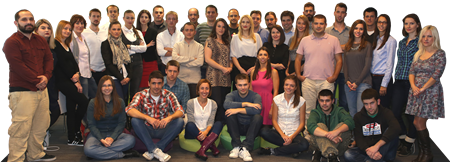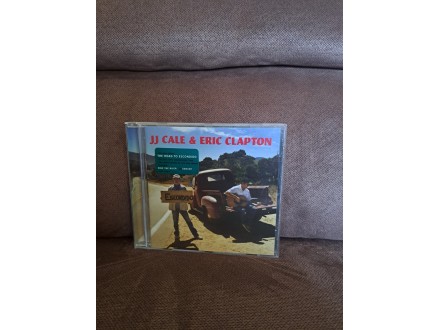JJ Cale & Eric Clapton - The Road To Escondido
| Cena: |
| Želi ovaj predmet: | 3 |
| Stanje: | Polovan bez oštećenja |
| Garancija: | Ne |
| Isporuka: | CC paket (Pošta) Post Express Lično preuzimanje |
| Plaćanje: | Tekući račun (pre slanja) Lično |
| Grad: |
Novi Sad, Novi Sad |
Izdavač: Ostalo
Žanr: Bluz, Rok
Poreklo: Strani izvođač
Original, made in EU
Knjizica od 12 str.
Odlicno ocuvano
knjizica 5 Cd 5-
Studio album by J. J. Cale and Eric Clapton
Released 7 November 2006
Recorded August 2005
Studio Los Angeles, California[1]
Genre Blues, blues rock, Tulsa Sound
Length 57:05
Label Duck / Reprise
Producer
J.J. CaleEric ClaptonSimon Climie
J. J. Cale chronology
To Tulsa and Back
(2004) The Road to Escondido
(2006) Rewind: The Unreleased Recordings
(2007)
Eric Clapton chronology
Back Home
(2005) The Road to Escondido
(2006) Complete Clapton
(2007)
The Road to Escondido is a collaborative studio album by J. J. Cale and Eric Clapton. It was released on 7 November 2006. Contained on this album are the final recordings of keyboardist Billy Preston. The album is jointly dedicated to Preston and Brian Roylance.
In 2004, Eric Clapton held the Crossroads Guitar Festival, a three-day festival in Dallas, Texas. Among the performers was J. J. Cale, giving Clapton the opportunity to ask Cale to produce an album for him. The two started working together and eventually decided to record an album. A number of high-profile musicians also agreed to work on the album, including Billy Preston, Derek Trucks, Taj Mahal, Pino Palladino, John Mayer, Steve Jordan, and Doyle Bramhall II. In a coup, whether intended or not, the entire John Mayer Trio participated on this album in one capacity or another.
Escondido is a city in San Diego County near Cale`s home at the time located in the small, unincorporated town of Valley Center, California. Eric Clapton owned a mansion in Escondido in the 1980s and early `90s. The road referenced in the album`s title is named Valley Center Road. It runs from Valley Center to Escondido. Cale and Clapton thought it would be a good name for the album because it connected the two locales.
The album won the Grammy Award for Best Contemporary Blues Album in 2008.
Background
Cale first came into Clapton`s orbit in the late sixties when he heard Cale`s obscure 1966 Liberty single `Slow Motion`, which featured `After Midnight` as the B-side. Clapton copied the arrangement of `After Midnight` and scored a radio hit with it in 1970. Cale, who worked for a time as an engineer in Leon Russell`s home studio in Los Angeles for a few years, was barely making ends meet in Tulsa when the song became a hit. Cale recalled to Mojo magazine that when he heard Clapton`s version playing on his radio, `I was dirt poor, not making enough to eat and I wasn`t a young man. I was in my thirties, so I was very happy. It was nice to make some money.`[11] Clapton then recorded other Cale songs, such as the 1977 hit `Cocaine`, and the songwriting royalties earned from artists like Clapton covering his songs enabled Cale to have a comfortable, if not commercially successful, recording career. In a 2014 interview with NPR, Clapton spoke about Cale`s influence on his music:
What seemed to evolve out of the `60s and into the `70s and then, in another way, the `80s — heavy metal came out of all of this stuff — was, like, volume and proficiency and virtuosity. There didn`t seem to be any reasonable limit to that; it was just crazy. I wanted to go in the other direction and try to find a way to make it minimal, but still have a great deal of substance. That was the essence of J.J.`s music to me, apart from the fact that he summed up so many of the different essences of American music: rock and jazz and folk, blues. He just seemed to have an understanding of it all.[12]
Clapton, who toured with Delaney & Bonnie in 1969, recalled in the 2005 documentary To Tulsa and Back, `Delaney Bramlett is the one that was responsible to get me singing. He was the one who turned me on to the Tulsa community. Bramlett produced my first solo album and `After Midnight` was on it, and those [Tulsa] players played on it. I mean, the first part of my solo career was really tailored on Cale`s philosophy. I mean, 461 Ocean Boulevard was my kind of homage to J.J.`
Despite their association in the public`s mind, the pair had rarely socialized or played together over the years, but in 2004 Clapton invited Cale to perform at his Crossroads Festival in Dallas. Cale, who was coming off an eight-year hiatus with the release of To Tulsa and Back, accepted, and it was during this period that Clapton asked him to produce his next album, which blossomed into a full-fledged collaboration.
Recording
Cale wrote 11 of the 14 tracks on the album, with two cuts, `Any Way the Wind Blows` and `Don`t Cry Sister`, being re-recordings of songs that Cale recorded previously in the seventies. Vocally, the pair`s singing styles are so symbiotic on the album that they are nearly indistinguishable, with Stephen Thomas Erlewine observing in his AllMusic review that the LP `reveals exactly how much Clapton learned from Cale`s singing; their timbre and phrasing is nearly identical, to the point that it`s frequently hard to discern who is singing when. Disconcerting this may be, but it`s hardly bad, since it never feels like Clapton is copying Cale; instead, it shows their connection, that they`re kindred spirits.` Musically the tone is relaxed and casual, a mix of bluesy grooves and up-tempo boogies that play to the duo`s strengths. The fiddle-driven `Dead End Road`, the galloping `Any Way the Wind Blows`, and the optimistic `Ride the River` exude the general vibe of camaraderie that permeates the recordings, while Clapton`s `Three Little Girls` speaks to the bliss of domestic life. The Brownie McGhee cover `The Sporting Life` and the seen-it-all minor blues `Hard to Thrill` (composed by Clapton and John Mayer) display the pair`s tasteful guitar licks and vocals.
Track listing
All songs by J. J. Cale except where noted.
`Danger` – 5:34
`Heads in Georgia` – 4:12
`Missing Person` – 4:26
`When This War Is Over` – 3:49
`Sporting Life Blues` (Brownie McGhee) – 3:31
`Dead End Road` – 3:30
`It`s Easy` – 4:19
`Hard to Thrill` (Eric Clapton, John Mayer) – 5:11
`Anyway the Wind Blows` – 3:56
`Three Little Girls` (Clapton) – 2:44
`Don`t Cry Sister` – 3:10
`Last Will and Testament` – 3:57
`Who Am I Telling You?` – 4:08
`Ride the River` – 4:35
Personnel
Musicians
J. J. Cale – vocals, keyboards, guitars
Eric Clapton – vocals, guitars
Billy Preston – Fender Rhodes, Wurlitzer electric piano, Hammond organ
Walt Richmond – acoustic piano, Fender Rhodes, Wurlitzer electric piano
Doyle Bramhall II – guitars
Christine Lakeland – acoustic guitar, backing vocals
Albert Lee – guitars
John Mayer – guitars
Derek Trucks – guitars
Nathan East – bass
Gary Gilmore – bass
Pino Palladino – bass
Willie Weeks – bass
Pino Palladino – bass
James Cruce – drums, percussion
Steve Jordan – drums
Jim Karstein – drums, percussion
Abe Laboriel Jr. – drums
Simon Climie – percussion, programming
David Teegarden – percussion
Taj Mahal – harmonica
Dennis Caplinger – fiddle
Marty Grebb – horns
Jerry Peterson – horns
Bruce Fowler – horns
Steve Madaio – horns
Production
Eric Clapton – producer, album cover concept
J. J. Cale – producer, mixing
Simon Climie – co-producer, Pro Tools engineer
Alan Douglas – recording, mixing
Jimmy Hoyson – assistant engineer
Phillippe Rose – assistant engineer
Brian Vibberts – assistant engineer
Mick Guzauski – mixing
Tom Bender – mix assistant
Joel Evenden – Pro Tools assistant
Bob Ludwig – mastering at Gateway Mastering (Portland, ME)
Bushbranch – management for Eric Clapton
Mike Kappus – management for J. J. Cale
Lee Dickson – guitar technician
Debbie Johnson – studio coordinator (Los Angeles)
Catherine Roylance – art direction, design
David McClister – location photography
Nathan East – additional studio photography
Christine Lakeland – additional studio photography
Jim Karstein – additional studio photography
Nigel Carroll – personal assistant to Eric Clapton, additional studio photography
Predmet šaljem nakon uplate na moj tekući račun ili po dogovoru.
Lično preuzimanje je uvek moguce u Novom Sadu po dogovoru,ili na mojoj adresi .
Molim kupce da pre licitacije pitaju sve sto ih zanima, kako bi izbegli eventualne nesporazume.
U slučaju bilo kakvog problema nakon preuzimanja paketa, kontaktirajte me pre davanja ocene kako bi isti pokusali da rešimo.
Ne šaljem pouzećem.
Za prodaju cd-ova : Plastične kutije su zamenjive i njih NE OCENJUJEM! Takodje zadnja strana iza plastike drzaca cd je vidljiva slika, za njih isto ne ide ocena, sve se vidi!
Predmet: 77511873











